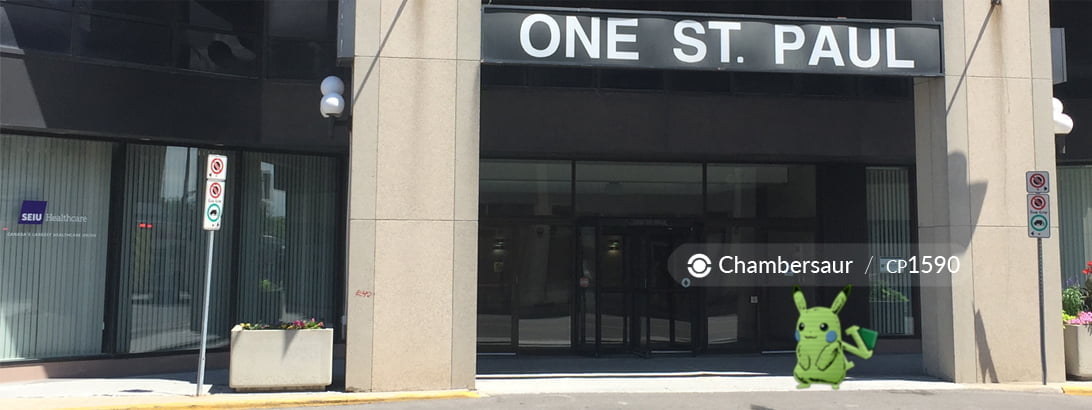On July 17, Niantic released Pokémon GO in Canada, although many had already been playing versions from other markets that were released earlier. The game is the latest instalment in the twenty-year-old Pokémon franchise that’s spawned games, films, TV shows, comics, and even a musical. “Pokémon” is short for the original Japanese title of “Pocket Monsters” (Poketto Monsutâ), and the correct pronunciation is “poh-kay-mon,” not “poe-kee-mon.”
The GO edition has players capturing, battling, and training virtual Pokémon that appear in augmented reality — on smart device screens when using their cameras to view the world. It’s been a massive commercial success. It quickly surpassed Candy Crush’s record for most-used smart device app, and increased the value of Nintendo’s shares by 50 per cent almost overnight.
The small crowds that build up at popular Pokéstops (locations where players can collect items and Poke Balls to capture more Pokémon) and gyms (places where players duel one another with their Pokémon to “capture” the gym for their team) have become a boon to local businesses. Yelp lets users search for Pokéstop businesses already. Restaurants and bars are seeing business increase 25 to 50 per cent. A survey at the GameStop chain, for instance, found that the 462 locations designated as gyms or Pokéstops had doubled their sales.
Did that get your attention?
Niantic placed most Pokéstops during the development of the game. If your business is a location, you might have already noticed Pokémon players wandering through your doors. Being a Pokéstop is free advertising — players will gravitate to your business without you having to spend a dime in marketing. There’s no current official map of all Pokéstop and gym locations, but you can install Niantic’s app Ingress, which maps locations virtually 1:1. If you find out that you’re a Pokémon location, it’s absolutely worth advertising that fact. Pokémon is big on social media — use the hashtags #Pokemon or #PokemonGO. Put signage out front and inside. Let people know and give word-of-mouth a helping hand.
If you’re a Pokéstop, you can really drive up traffic by throwing Lures out. A Lure dramatically increases the rate of Pokémon that appear around the location for half an hour, and therefore will dramatically increase the number of players who come to your business. Lures are dirt-cheap as far as marketing goes. An eight-pack of Lures costs 680 Pokecoins; $130 CAD gets you 14,500 Pokecoins, making luring cost you about $1.55 an hour.
To throw out Lures, install the game, tap the red Pokeball at the bottom of the game’s display, tap “shop,” and tap the lures to purchase them (they look like purple boxes). Once you’ve bought them, tap the red Pokeball again, tap “Items,” and then tap the lure to activate it. Repeat every thirty minutes. When your lure is out, your Pokéstop will show up on players’ maps with pink flowers around it, letting them know it’s a hotspot for Pokémon.
Lures can’t be deployed at gyms, but you don’t have to — gyms are big draws on their own. Players will come to “capture” the gym for one of the three teams: Mystic, Valor, and Instinct (don’t worry, it’s all virtual!). To see if you’re near a gym, check the Ingress map or open the game on your phone. You’ll spot them — they’re the biggest structures on the in-game map. Capitalizing on being a gym, or near a gym, takes a little more effort, but can yield big rewards.
Some ideas that businesses have implemented include discounts for members of the team that currently controls the gym. Put up a sign announcing which team is currently in control. You can find out easily enough from the app — or just wait for players to tell you (don’t worry, they will). The discounts you give to players on the controlling team will be more than offset by the business you get from players on the opposing teams who arrive to try and capture the location. You can also order Pokemon gym badges customized for your business. You can get designs for free (Google “custom Pokemon gym badges” for examples). The GNCC’s member directory has many local businesses making high-quality signs that’ll draw players into your location.
What if you’re not a gym or Pokéstop? You can make a request to become a Pokéstop or gym with Niantic’s online request form. Lots of organizations have. If your business is mobile, you can use the app to set up shop near a Pokéstop or a gym and use the strategies above. Try and find a location near several Pokéstops, and put down a lure for each. There’ll be a crowd in no time.
You can still get in on the action without being a gym or a Pokéstop, although those locations are obviously ideal. There will still be wild Pokémon that pop up at your location. Advertise them! Here’s a handy chart of Pokémon by rarity from Redditor RotomGuy. Players can use Incense to get more Pokémon, which is like a lure, but only for the player who put it down. Ask players who find rare Pokémon to tag your business in social media and upload a picture of the Pokémon they caught. Maybe offer them a discount or to pay for their Incense. Once word gets out that your business is a good place to find rare Pokémon, players will start to show up.
These are certainly exciting times for players, with more people using the game every day than Twitter. Maybe this is a fad and will pass quickly, but that doesn’t mean you can’t build your business’s reputation and customer base while it’s hot. Some of the players you bring in may turn out to be lifelong customers even after Pokémon has gone the way of Beanie Babies, Furbies, Napster, and MySpace (remember those?). Of course, Pokémon has been around for twenty years now, so it might take a while…



